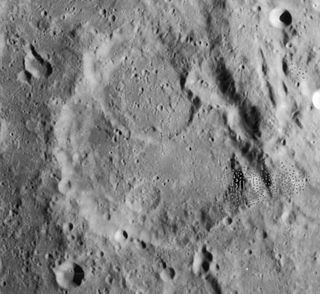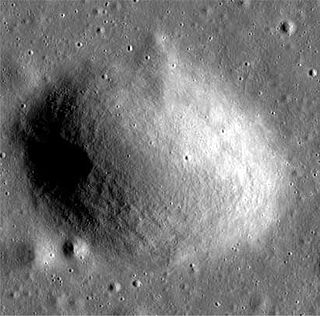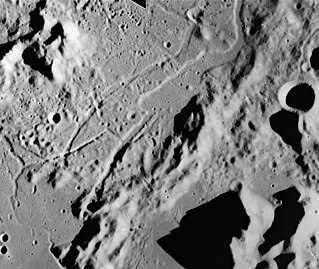
Mare Humorum is a lunar mare. The impact basin it is located in is 425 kilometers across.

Mare Nubium is a lunar mare in the Nubium basin on the Moon's near side. The mare is located just to the southeast of Oceanus Procellarum.

Birt is a lunar impact crater located in the eastern half of the Mare Nubium and west of the Rupes Recta. It was named after British selenographer William R. Birt.

Catharina is an ancient lunar impact crater located in the southern highlands. It was named after Saint Catherine of Alexandria. It lies in a rugged stretch of land between the Rupes Altai scarp to the west and Mare Nectaris in the east. To the west-northwest is the crater Tacitus, and the lava-flooded Beaumont lies to the east along the shore of Mare Nectaris. To the south-southeast is Polybius.

Fahrenheit is a tiny lunar impact crater located in the southeast part of the Mare Crisium. This area of the surface is nearly devoid of impact features of interest. To the east are the Dorsa Harker wrinkle ridges, and beyond them is Promontorium Agarum at the edge of the mare. The landing site of the Soviet Luna 24 probe is located about 15 kilometers to the southeast.

Cauchy is a small lunar impact crater on the eastern Mare Tranquillitatis. It was named after French mathematician Augustin-Louis Cauchy. It is circular and symmetric, with a small interior floor at the midpoint of the sloping inner walls. Due to the high albedo of this bowl-shaped formation, it is particularly prominent at full Moon.

Vitello is a lunar impact crater that lies along the southern edge of the small Mare Humorum, in the southwest part of the Moon's near side. It was named after 13th century Polish theologian and physicist Vitello. It lies just to the east of the lava-flooded crater Lee. To the northeast along the edge of the lunar mare is the Rupes Kelvin, an irregular fault line.

Verona Rupes is a cliff on Miranda, a moon of Uranus. It was discovered by the Voyager 2 space probe in January 1986. The cliff face, previously thought to be from 5 to 10 km high, as of 2016 is estimated to be 20 km (12 mi) high, which makes it the tallest known cliff in the Solar System.

Donna is a tiny lunar crater on the near side of the Moon. Its name is an Italian female given name, and does not refer to a specific person. It is located in the eastern half of the Mare Tranquillitatis, at the summit of the lunar dome Omega (ω) Cauchy. As such domes are thought to be volcanic in nature, it appears likely that this crater was created by an eruption. This is in contrast to most lunar craters, which are now believed to be created by impacts. This crater is sufficiently small that it requires a large telescope to resolve.

Cassini is a lunar impact crater that is located in the Palus Nebularum, at the eastern end of Mare Imbrium. The crater was named after astronomers Giovanni Cassini and Jacques Cassini. To the northeast is the Promontorium Agassiz, the southern tip of the Montes Alpes mountain range. South by south-east of Cassini is the crater Theaetetus. To the northwest is the lone peak Mons Piton.

Rimae Fresnel is a 90km-long arcuate escarpment on the Moon at 28.0°N 4.0°E. Both the escarpment and the nearby Promontorium Fresnel were named after the French physicist Augustin-Jean Fresnel.
Rupes is the Latin word for 'cliff'. It is used in planetary geology to refer to escarpments on other worlds. As of January 2013, the IAU has named 62 such features in the Solar System, on Mercury (17), Venus (7), the Moon (8), Mars (23), the asteroids Vesta (2) and Lutetia (2), and Uranus's satellites Miranda (2) and Titania (1).

Promontorium Laplace is a raised mountainous cape situated at the end of Montes Jura in Mare Imbrium on the near side of the Moon. Its selenographic coordinates are 46.8° N, 25.5° W and it is 2600 meters high. It forms the northeast boundary of the bay of Sinus Iridum.

Promontorium Heraclides is a raised mountainous cape situated in Mare Imbrium on the near side of the Moon. Its selenographic coordinates are 40.3° N, 33.2° W and it is 50 km in diameter. It marks the western edge of the bay of Sinus Iridum. Promontorium Heraclides is named after Heraclides Ponticus, a Greek philosopher and astronomer. The Soviet lunar probe Luna 17 landed about 30 km from Promontorium Heraclides on November 17, 1970. The land form is depicted as the face of a woman looking across Sinus Iridum in a 1679 lunar map by Giovanni Domenico Cassini; this depiction, of disputed origin, is known as the "Moon Maiden".

Promontorium Agarum is a raised mountainous cape protruding into the southeast of Mare Crisium on the near side of the Moon. It protrudes into the mare up to 40 km and its width is about 80 km. Its coordinates are 13.87°N 65.73°E.

Promontorium Taenarium is a headland on the near side of the Moon. It is located in the eastern end of Mare Nubium. Its length is about 70 km. Its coordinates are 18°39′0″S7°28′24″W.

Promontorium Archerusia is a headland on the near side of the Moon. It separates the lunar mares of Mare Serenitatis and Mare Tranquilitatis. Its coordinates are 16.8°N 21.9°E.

Promontorium Fresnel is a headland on the near side of the Moon. It is located at the northern end of the Montes Apenninus and separates the lunar mares of Mare Serenitatis and Mare Imbrium. Just west of the mountainous cape is Rimae Fresnel. Both features were named after the French physicist Augustin-Jean Fresnel. Its coordinates are 28.63°N 4.75°E.

Promontorium Kelvin is a headland on the near side of the Moon. It is located in the southeast of the Mare Humorum. It is close to Rupes Kelvin. Its length is about 45 km. Its coordinates are 26.95°S 33.45°W. It was named after the British scientist, physicist and engineer William Thomson, 1st Baron Kelvin.


















